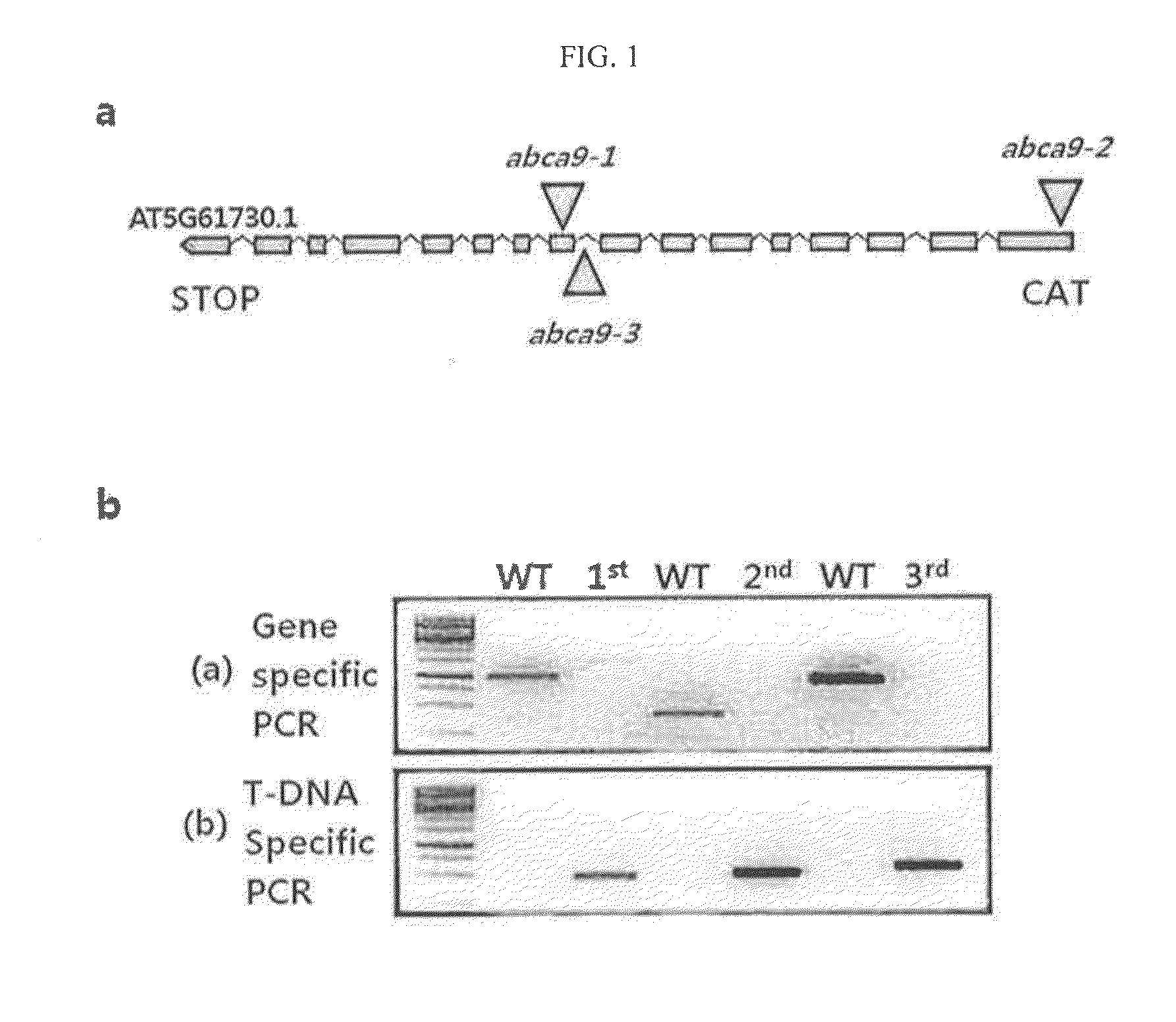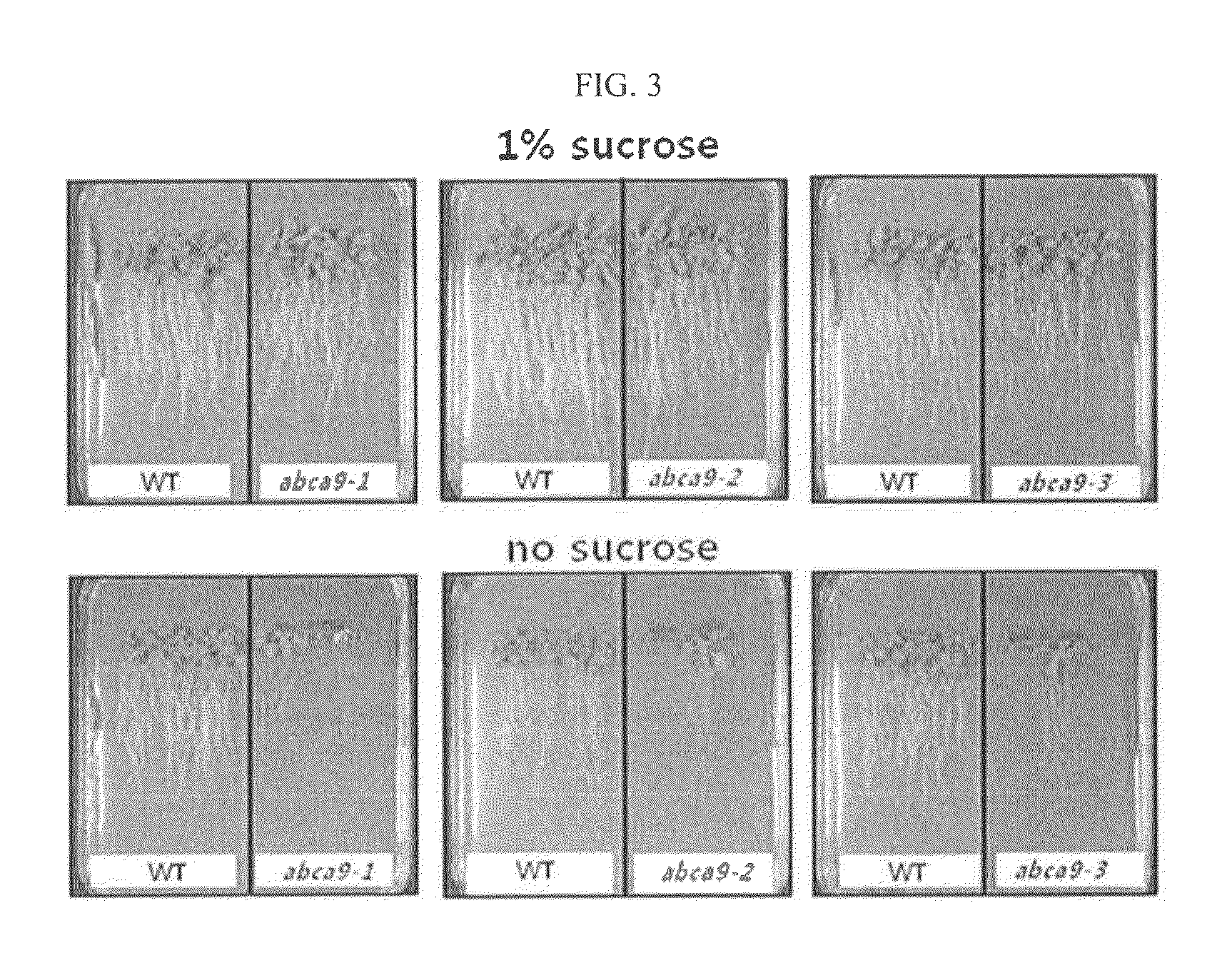Composition containing gene encoding abc transporter proteins for increasing size of plant seed and content of fat stored within seed
a technology of plant seed and transporter protein, which is applied in the direction of biocide, animal repellents, peptide sources, etc., can solve the problems of inability to catch up with demand, supply tends to increase, and difficulty in catching up with demand in a limited cultivation area, so as to increase the weight of seed, and increase the size of plant seed.
- Summary
- Abstract
- Description
- Claims
- Application Information
AI Technical Summary
Benefits of technology
Problems solved by technology
Method used
Image
Examples
example 1
Isolation of Arabidopsis thaliana that Can't Express AtABCA9 / AtATH11
[0061]To search for a mutant incapable of expressing AtABCA9 / AtATH11 due to the insertion of T-DNA into the AtABCA9 / AtATH11 gene, a mutant with T-DNA inserted in three different sites was ordered from SALK Institute (http: / / signal.salk.edu / ) (FIG. 1a) The three mutants ordered were SALK—058070: abca9-1, SALK—084342: abca9-2, and SALK—023744:abca9-3, and the three mutants and wild-type (Columbia-0, SALK institute) Arabidopsis thaliana went cultured for 2 weeks in a ½ MS medium (Murashige and Skoog, 1962) containing kanamycin and extracted genomic DNA of each and identified the knockout status of genes.
[0062]In detail, the genomic DNA extracted from the Example 1 method was the template and performer the gene (AtABCA9 / AtATH11)—specific PCR and T-DNA-specific PCR response, and for the PCR response, the following primers were used.
LIST OF PRIMERS USED
[0063]
1. pROKLBb1 (SEQ ID NO: 3:5′-GCGTGGAACCGCTTGCTGCAACT-3′)2. S...
example 2
Effect of AtABCA9 / AtATH11 Gene on Germination and Growth of Plant
example 2-1
Effectiveness Measurement on Germination Rate
[0070]To measure germination rates of Arabidopsis thaliana mutants that can't express AtABCA9 / AtATH11 (abca9-1, abca9-2, abca9-3) identified in Example 1 and the wild-type (Columbia-0, SALK institute), each seeds were planted in a ½ MS medium (Murashige and Skoog, 1962), and was monitored after 48 hrs at intervals of 12 hrs by optical microscopy. Germination was determined on the basis of the emergence of radicles.
[0071]The observation result, as shown in FIG. 2, while the wild-type was 98% germinated after 48 hrs since the seed was planted in the medium, the mutant that can't express AtABCA9 / AtATH11 showed late germination comparing to wild-type due to small and crumpled seed, and even if it was germinated, only 20˜40% were germinated, and roughly 20% of the mutant did not germinate to the end.
PUM
| Property | Measurement | Unit |
|---|---|---|
| pH | aaaaa | aaaaa |
| pH | aaaaa | aaaaa |
| temperature | aaaaa | aaaaa |
Abstract
Description
Claims
Application Information
 Login to View More
Login to View More - R&D
- Intellectual Property
- Life Sciences
- Materials
- Tech Scout
- Unparalleled Data Quality
- Higher Quality Content
- 60% Fewer Hallucinations
Browse by: Latest US Patents, China's latest patents, Technical Efficacy Thesaurus, Application Domain, Technology Topic, Popular Technical Reports.
© 2025 PatSnap. All rights reserved.Legal|Privacy policy|Modern Slavery Act Transparency Statement|Sitemap|About US| Contact US: help@patsnap.com



